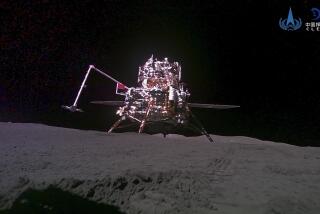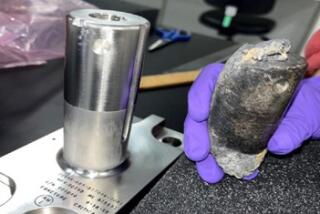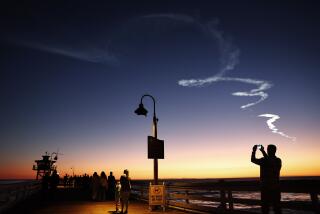NASA moon crash did kick up debris plume as hoped
- Share via
NASA’s recent lunar-punch mission apparently was not the high-profile flop it first appeared.
Officials at Ames Research Center in Northern California, which managed the mission, released images Friday that clearly show a plume of debris from the Cabeus crater shortly after the space agency’s rocket plowed into it.
The plume reached an estimated mile above the lunar surface.
Creating a plume was key to the mission’s success because the goal was to measure dust kicked up by the Centaur rocket to find out whether ice might lie hidden in polar craters that haven’t seen sunlight in billions of years. To do that, the accompanying $79-million Lunar Crater Observation and Sensing Satellite was to fly through the debris cloud so its spectrometers and cameras could sample the lunar dust.
Everything appeared to go as planned in the early morning hours of Oct. 9, except that no debris plume appeared as the LCROSS satellite followed the Centaur into the crater.
Hundreds of members of the public, who had gathered at Ames’ campus in Mountain View to watch the 4:30 a.m. event on a huge outdoor movie screen, were disappointed to see only a close-up of the craggy lunar surface before the screen went black when the satellite crashed.
At the time, NASA scientists said they hoped the problem was simply that cameras aboard the satellite were not properly adjusted to detect the plume. But some scientists feared the Centaur might have hit bedrock and failed to create a plume. The new images, lifted from a different camera aboard the spacecraft, show that a plume did, in fact, occur. That means the satellite should have been capable of detecting water, if it was present.
“We are blown away by the data returned,” Tony Colaprete, the mission’s top scientist, said in a statement. “The team is working hard on the analysis, and the data appear to be of very high quality.”
Colaprete said that it was too early to say what the plume contained but that several clues, including the temperature of the flash created by the crash, will help scientists find out in coming weeks.
Finding significant amounts of water on the moon would be a major discovery, making eventual colonization easier than it would be if settlers had to transport water from Earth.
More to Read
Sign up for Essential California
The most important California stories and recommendations in your inbox every morning.
You may occasionally receive promotional content from the Los Angeles Times.










